Newest Trends in Flooring for Education, Sports, and Recreation Facilities
Previously published by The Flooring Contractor Magazine.
Today there are more options in flooring systems than ever before. New technologies offer higher performance and environmentally friendly choices in all applications.
Trends in High School/University Sports Floors
High schools and universities make the most demanding requirements for sports flooring. They offer every type of physical activity, from swimming to weight training, and at the highest levels of performance. Here are some of the many solutions for these facilities.
Hardwood
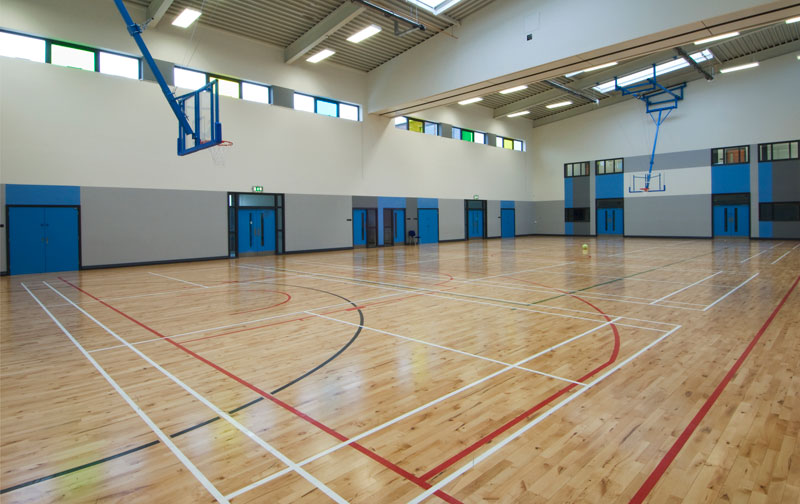
New material technologies allow today’s hardwood floors to match the performance of traditional floors with much simpler and less expensive systems.
Hardwood is still the most versatile and durable floor for gymnasiums, but it’s also a good choice for multi-purpose facilities that accommodate everything from aerobics to basketball and other physical activities.
Hardwood gymnasium floors are made almost exclusively from northern hard maple, although a few manufacturers now offer beech. These hardwoods’ dense, hard grain wears well and keeps grime from being ground into the wood. The hardwood planks are strong but flexible, and when they’re installed over a proper subfloor system, they provide the flexibility, spring, and stability required by ball sports.
The traditional hardwood sports floor consists of hardwood planks over a continuous wood underlayment, supported by sleepers resting on the permanent subfloor, usually concrete.
However, new material technologies allow today’s hardwood floors to match the performance of traditional floors with simpler and less expensive systems. Premium hardwood floors are now offered with a continuous resilient underlayment of rubber or poly foam instead of sleepers. Combined with the continuous wood subfloor, these floors provide spring, flexibility, ball rebound, and stability comparable with traditional floors at a much lower cost.
These same technologies have also made floating hardwood sports floors possible. Instead of being permanently installed, these floors are made in modular sections with integral underlayment. The modular sections are then assembled into a complete floor with no attachment to the subfloor. The floor can be quickly and easily dismantled, stored, and even transported to other locations. This allows tremendous flexibility for the sports facility. Floors can be assembled for sports and then removed and stored for other functions such as assemblies and parties. It even allows temporary floors to be set up in other locations for tournaments, field days and other special events.
Rolled Vinyl
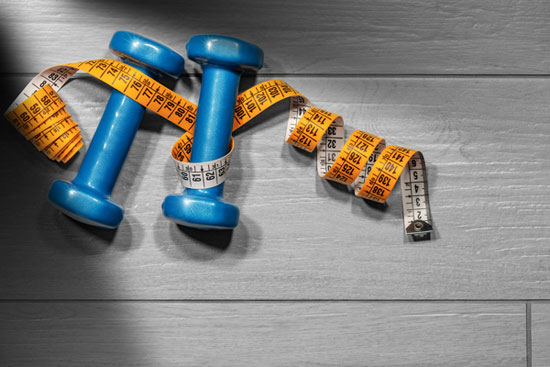
Its low cost and durability make rolled vinyl a perfect choice for common areas and hallways, and all high traffic areas.
Rolled vinyl offers an economical, easy-to-install and easy-to-maintain alternative to premium hardwood and poured polyurethane. It offers good shock absorption, slip resistance and durability. It provides a non-porous, seamless surface that is waterproof and hygienic. It’s suitable for all the same applications as poured urethane, including gyms, aerobics areas, locker rooms, and weight training rooms.
In addition, rolled vinyl can support heavy static and rolling loads that would damage poured polyurethane or hardwood. Its low cost and durability make it a perfect choice for common areas and hallways, and all high traffic areas.
Rolled vinyl is also available in systems for wet areas, such as pool areas, locker rooms, showers, and steam rooms. For these applications, the flooring material is provided with a slip-resistant finish and is treated with a bacteriostat for a hygienic environment. The products are installed with adhesive, and the seams between sheets are then heat-welded to provide a seamless surface.
Interlocking Plastic Tiles
One of the most innovative new developments in flooring systems is interlocking polypropylene plastic tiles for sports floors. These tiles snap together quickly and easily to assemble a complete sports floor. They’re installed as a floating floor without adhesive, so they can easily be disassembled, transported and stored. They’re suitable for basketball, volleyball or any other activity that a traditional hardwood gymnasium floor can support.
Plastic tile floors can be customized with colors, lines, and graphics, just like permanent hardwood and polyurethane floors. Because they’re modular, individual tiles can be replaced if they are damaged. Installation is quick and inexpensive. This makes them one of the most cost-effective, and versatile systems available.
New Technologies Still Subject to “Old School” Flooring Failure
Flooring systems have come a long way in recent years, but there’s still no such thing as a failure-proof floor. Improved materials are more durable and easier to install, but the fact remains that installing any flooring system requires strict adherence to established best practices. Most problems with floors haven’t changed. Here are some ways that floors can fail, and what you can do to help prevent the pro flooring installers worst nightmare.
No Allowance for Expansion
As floating wood floors expand and contract with temperature, they move relative to the subfloor. If the floor has no room to expand, it can cause buckling, squeaking and popping and other problems.
To avoid problems, install enough expansion joints at proper intervals. Leave enough expansion space around the edges of the floor. And don’t nail molding or transition strips to the floating floor, because this can also prevent the floor from moving freely.
Contaminated Subfloor
Subfloors, especially concrete, can be contaminated with grease and oil. If the floor isn’t cleaned and prepped properly, floor coatings and adhesives can fail. Coatings can separate from the floor causing bubbles. Adhesives can dissolve, causing oozing and delamination of the floor.
To avoid problems, make sure that a contaminated subfloor is properly cleaned before applying the floor. Acid etching might be necessary to open the pores of the concrete. In some cases, the floor might need to be ground and shot blasted.
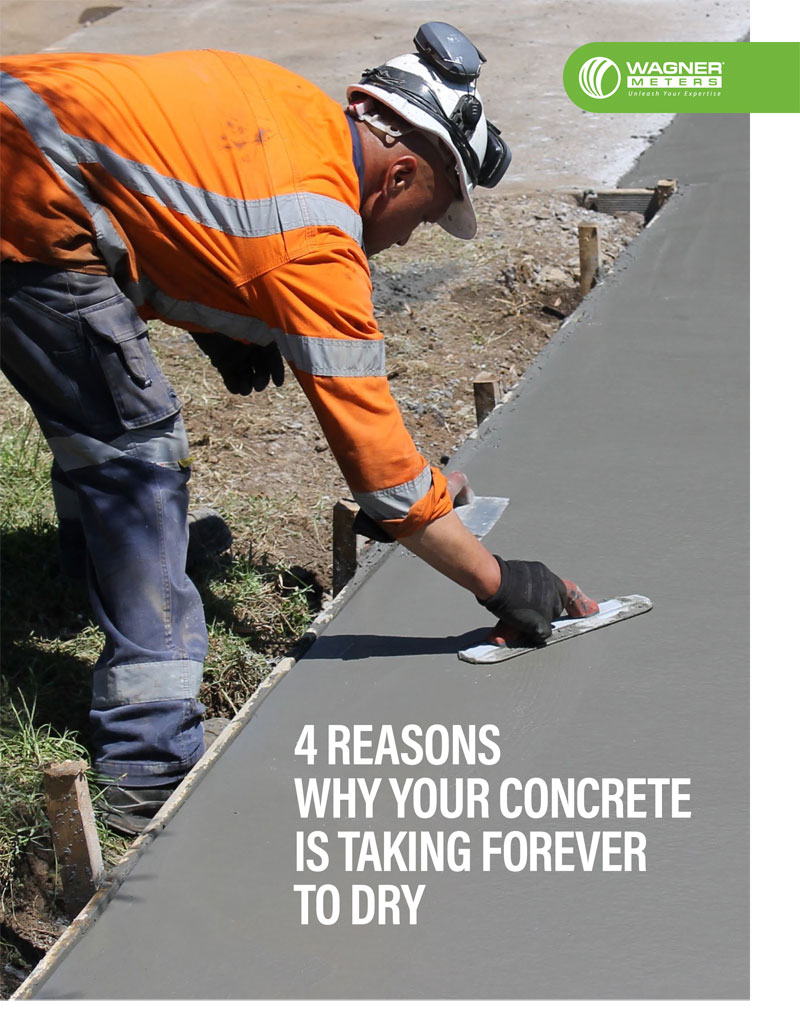
Free Download – 4 Reasons Why Your Concrete Is Taking Forever to Dry
Uneven Subfloor
If the permanent subfloor is not smooth and even, it can cause bumps in rubber or vinyl flooring. Modular floor sections can be difficult to assemble. Wood floors can buckle or develop gaps.
To prevent this, be sure that the floor is troweled, ground, or skimmed as necessary to achieve a smooth even surface. Sometimes, installing a self-leveling overlay may be necessary to sufficiently even out the subfloor before the flooring system is installed.
Improperly Applied Materials
Poured and coated materials require careful mixing before they are applied. Mixing ratios must be correct, and the materials must be applied within the specified time window. Materials must be applied under suitable ambient temperature and humidity conditions. If the correct procedures aren’t followed, the result can be delamination of the coatings and cloudy appearance.
Moisture
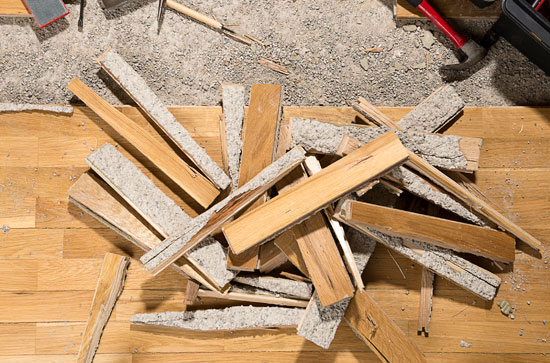
About 80% of all flooring failures are due to moisture emitted from a concrete subfloor. This includes coatings, vinyl, rubber, poured polyurethane, wood, laminates, and carpet.
There can be many causes of excessive moisture. The slab might be constructed with no vapor retarder or a compromised retarder. The concrete might not be sufficiently dried after curing.
The potential problems from excessive moisture are numerous. They include:
- Mold and mildew
- Bubbling and delamination of coated and poured floors
- Adhesive failure
- Adhesive oozing
- Buckling
- Cracking, tenting, warping, squeaking and popping in wood floors
Proper construction utilizing properly placed vapor retarders can help prevent many moisture-related flooring failures. But moisture in concrete slabs comes from many sources, and without the proper equipment and procedures, it’s difficult to know when a slab is sufficiently dry to install the flooring system. Fortunately, new standards and technology make flooring failures due to excess moisture more preventable than ever.
Relative Humidity Testing for Concrete Slabs
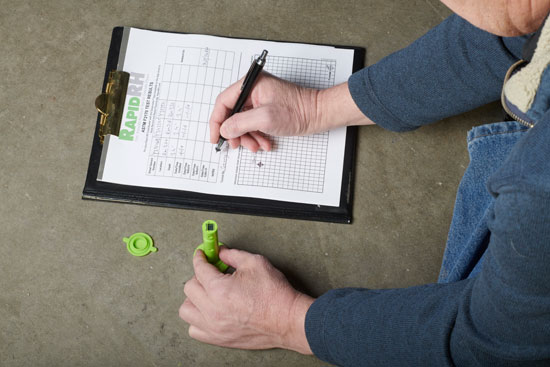
ASTM F2170 for RH testing with in-situ probes is the newest, most accurate and reliable standard, and it’s also the fastest and easiest to perform.
ASTM has continuously developed standards for testing moisture in concrete slabs. ASTM F2170 for RH testing with in-situ probes is the newest, most accurate and reliable standard, and it’s also the fastest and easiest to perform. Using this new standard to test your concrete slabs before installing any flooring system can cut installation time and costs, and lower your risk of flooring failures.
The Wagner Rapid RH® system is easy to use and fast way to test concrete slabs in full compliance with ASTM F2170. Although the standard specifies a minimum 24-hour equilibration period, the Rapid RH system can provide useful preliminary results to within 3-5% of the final numbers in less than an hour after the probes are installed. This allows you to make scheduling and other business decisions sooner.
The Rapid RH L6 single usage probes can be installed to the precise depth required and remain in the slab afterward for subsequent testing as needed.
The Rapid RH 5.0 reusable system provides a reusable probe where large quantities of tests are required over a short time frame. This system typically benefits inspectors who visit a larger number of job sites per week or month.
Jason has 20+ years’ experience in sales and sales management in a spectrum of industries and has successfully launched a variety of products to the market, including the original Rapid RH® concrete moisture tests. He currently works with Wagner Meters as our Rapid RH® product sales manager.
Related Posts via Taxonomies
Last updated on June 1st, 2021




Jason,
Good information. I have been recommending your testing equipment to flooring contractors for years and still have the sample you made for me to educate architects that shows the RH sleeve in the concrete. Moisture is only half of the reason why flooring systems fail on existing concrete. The other reason is elevated soluble salts which with the moisture forms the osmotic blistering to happen. Most flooring manufacturers have their head in the sand and don’t understand this phenomena.
Regards,
Sam Sacks CSI, CDT
Northeast Regional Manager
Dur-A-Flex Inc.